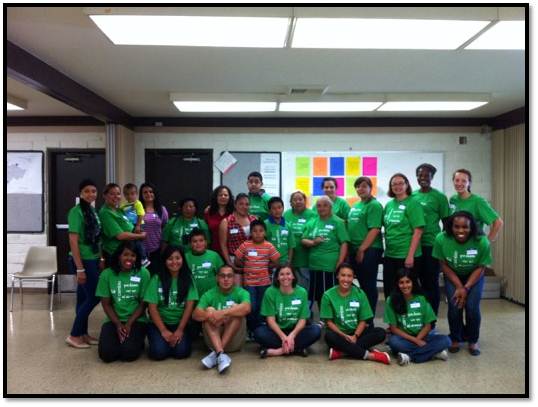
Share On Social!
Folks at Stanford University are empowering Latino youth and seniors to work towards an improved built environment for their community.
In 2013, a team of researchers from the Healthy Aging Research and Technology Solutions (HARTS) lab at the Stanford Prevention Research Center, led by Abby C King, Ph.D., teamed up with adolescents and older adults from a low-income neighborhood in the predominantly Latino (73%) city of North Fair Oaks, CA to assess features of the neighborhood environment that help or hinder healthy active living. The researchers, led by Dr. Sandra Winter, a Postdoctoral Research Fellow at Stanford, and Lisa Goldman Rosas, an Instructor of Medicine, partnered with a Public Health Educator, Priscilla Padilla-Romero, from the Fair Oaks Health Center.
“There are a lot of issues and challenges in the area,” Padilla-Romero said. “New immigrants face substantial challenges on a daily basis such as high unemployment rates, and significant social stressors.” Additionally, Dr. Goldman Rosas mentioned that, “Many immigrants point out that their lifestyles were naturally more active in their countries of origin and when they move to the US they have to think about how to get more physical activity for the first time.”
The neighborhood of North Fair Oaks happens to be located just 4 miles from Facebook’s billion dollar company in the Silicon Valley, home to some of the world’s wealthiest technology firms. Yet blocks away, huge disparities in the built environment exist.
In order to empower the community and help build capacity, the HARTS team saw an opportunity to work with local residents.

The idea was to enable them to become “citizen scientists” by providing them with an easy-to-use tool to survey their streets. The Stanford Healthy Neighborhood Discovery Tool (Discovery Tool), uses Global Positioning System (GPS) technology along with photos and audio recordings that are geocoded, to communicate to policy makers and leaders which areas are in greatest need of improvement.
Initially, the Discovery Tool was tested in a study with low-income, elderly individuals, but because Latinos are less likely than their non-Latino white peers to have safe places for activity, Winter wanted to see if it could be adapted for use by Latinos of varying age groups.
With support from a Stanford Translational Science Seed Grant, Winter and Padilla-Romero recruited local youth and senior citizens to join the study.
Starting in January 2013, middle school students and older adults walked throughout their neighborhood using the Discovery Tool to identify barriers and facilitators to active living.
Each neighborhood walk lasted approximately 36 minutes and together the participants took a total of 224 photos and audio recordings.
The features that were reported as being facilitators of physical activity by the greatest number of participants were:
- Having amenities and destinations to walk to
- The presence of good quality sidewalks
- The presence of parks, playgrounds and crosswalks
- The aesthetic feel of the neighborhood (for example, attractive plants and well maintained homes)
The features that were reported as being barriers to physical activity by the greatest number of participants were:
- Poor quality sidewalks
- Trash and illegal dumping
- Personal safety
At a meeting in June 2013, participants reviewed their photographs and audio recordings and prioritized the three top issues that were of greatest concern and that they would like to see addressed: trash & Illegal dumping; personal safety; and improving sidewalk quality.
“The citizens decided which issues they felt needed to be resolved to promote physical activity in the community,” Winter said.
At the June meeting, the citizen scientists received advocacy skills training and handouts and chose four adults and three youth to represent the neighborhood at a subsequent August 2013 meeting with county officials.
Winter said: “We connected the residents with partners in the community who could potentially help them address their areas of concern and created a community resource guide with additional contact information that was distributed to study participants and local community-based organizations.”
As a result of the August meeting, Winter said both parties gained valuable information from each other and the findings from the study placed greater attention on the issue of illegal dumping in the community.

According to Padilla-Romero, Latino youth in North Fair Oaks are hearing the message about improving their community and working to implement aspects of the North Fair Oaks Community plan, which features a whole chapter on Health and Wellness.
“We’ve noticed that some residents, including youth from the study, had a stake in creating open spaces such as pocket parks near their home,” Padilla-Romero said. “So they’re hearing the message from various groups in the community.”
Through the North Fair Oaks Forward initiative, a group of local leaders are working to bring healthy changes to the neighborhood Padilla-Romero said.
Winter hopes that the study’s findings will continue to inform local policy and bring improvements to the built environment.
“The challenge when you’re involved in policy is that it does take a long time,” Winter said. “A lot of the initiatives are long-term, like five-ten years, however, there’s potential for monitoring people going forward to see how they’ve progressed over time.”
Read more about the Standford Healthy Neighborhood Discovery Tool (Discovery Tool) here.
Explore More:
Healthy Families & SchoolsBy The Numbers
142
Percent
Expected rise in Latino cancer cases in coming years




